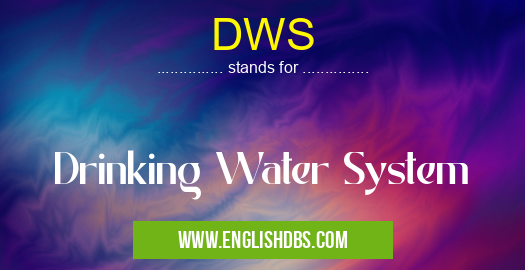What does DWS mean in UNCLASSIFIED
DWS stands for Drinking Water System. It refers to the infrastructure and processes involved in the treatment, distribution, and monitoring of water intended for human consumption. The primary goal of a DWS is to ensure that the water supplied to consumers meets established drinking water standards and is safe for consumption.

DWS meaning in Unclassified in Miscellaneous
DWS mostly used in an acronym Unclassified in Category Miscellaneous that means Drinking Water System
Shorthand: DWS,
Full Form: Drinking Water System
For more information of "Drinking Water System", see the section below.
Components of a DWS
- Source: The source of water for a DWS can be groundwater (wells), surface water (lakes, rivers), or a combination of both.
- Treatment: Raw water undergoes various treatment processes to remove impurities, pathogens, and contaminants. These processes may include coagulation, filtration, disinfection, and others.
- Distribution: Treated water is distributed to consumers through a network of pipes and valves.
- Monitoring: Regular monitoring is conducted throughout the DWS to ensure compliance with drinking water standards and identify potential issues.
Importance of DWS
- Public Health: A safe and reliable DWS is essential for protecting public health by preventing waterborne diseases.
- Economic Development: Access to clean water is crucial for economic development and productivity.
- Environmental Sustainability: DWSs contribute to environmental sustainability by reducing the use of bottled water, minimizing water waste, and protecting water sources.
Essential Questions and Answers on Drinking Water System in "MISCELLANEOUS»UNFILED"
What is a Drinking Water System (DWS)?
A DWS is a set of components that provides water for drinking and other household purposes, such as piping, treatment facilities, storage tanks, and wells. It can be public (providing water to multiple customers) or private (serving a single household).
What are the types of DWSs?
DWSs can be categorized into three main types:
- Community Water Systems: Serve at least 15 service connections or 25 people year-round.
- Non-Community Water Systems: Provide water to the public, such as schools, parks, or businesses, but do not serve more than 15 service connections or 25 people year-round.
- Private Wells: Provide water to a single household or property and are not connected to a public water supply.
How are DWSs regulated?
DWSs are regulated by government agencies to ensure the safety and quality of drinking water. These agencies set standards for water quality, treatment, and monitoring. In the US, the Environmental Protection Agency (EPA) and state agencies enforce these regulations.
What is the difference between a DWS and a wastewater system?
A DWS is designed to provide clean water for consumption, while a wastewater system collects and treats wastewater (sewage) from homes and businesses. The two systems are separate and do not mix.
How can I find out if my water comes from a DWS?
You can contact your local water utility or municipality to determine if you are connected to a DWS. They can also provide information about the quality of your drinking water.
What should I do if my water is contaminated?
If you suspect your drinking water is contaminated, you should immediately contact your local water utility or health department. They will advise you on how to proceed and may provide bottled water or alternative sources of drinking water.
Final Words: DWS is a vital component of modern infrastructure, ensuring the provision of safe and clean drinking water for communities. It requires continuous maintenance, monitoring, and investment to maintain its effectiveness and protect public health. Understanding the concept of DWS is essential for policymakers, water utilities, and the general public to appreciate the importance of this critical system.
DWS also stands for: |
|
| All stands for DWS |
